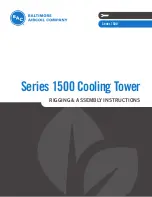
Page 5
Installed in Combination with a Cooling Coil
When this furnace is used with cooling units, it shall be in-
stalled in parallel with, or on the upstream side of, cooling
units to avoid condensation in the heating compartment.
See figure 1. With a parallel flow arrangement, a damper
(or other means to control the flow of air) must adequately
prevent chilled air from entering the furnace. If the damper
is manually operated, it must be equipped to prevent op-
eration of either the heating or the cooling unit, unless it is
in the full HEAT or COOL setting. See figure 1.
Gas Unit
Heating Unit Installed Upstream of Cooling Unit
Gas Unit
Dampers
(open during heating operation only)
Dampers
(open during cooling operation only)
Heating Unit Installed Parallell to Air Handler Unit
Air Handler Unit
Evaporator
FIGURE 2
When installed, this furnace must be electrically grounded
according to local codes. In addition, in the United States,
installation must conform with the current National Elec-
tric Code, ANSI/NFPA No. 70. The National Electric Code
(ANSI/NFPA No. 70) is available from the following ad-
dress:
National Fire Protection Association
1 Battery March Park
Quincy, MA 02269
NOTE - This furnace is designed for a minimum contin-
uous return air temperature of 60°F (16°C) or an inter-
mittent operation down to 55°F (13°C) dry bulb for cases
where a night setback thermostat is used. Return air tem-
perature must not exceed 85°F (29°C) dry bulb.
The SL280UHV furnace may be installed in alcoves, clos-
ets, attics, basements, garages, and utility rooms in the
upflow or horizontal position.
This furnace is not designed for installation in mobile
homes, recreational vehicles, or outdoors.
Never use an open flame to test for gas leaks. Check all
connections using a commercially available soap solution
made specifically for leak detection.
Use of Furnace as Construction Heater
Lennox does not recommend the use of SL280UHV units
as a construction heater during any phase of construc-
tion. Very low return air temperatures, harmful vapors and
operation of the unit with clogged or misplaced filters will
damage the unit.
SL280UHV units may be used for heating of buildings or
structures under construction, if the following conditions
are met:
• The vent system must be permanently installed per
these installation instructions.
• A room thermostat must control the furnace. The use of
fixed jumpers that will provide continuous heating is not
allowed.
• The return air duct must be provided and sealed to the
furnace.
• Return air temperature range between 60°F (16°C) and
80°F (27°C) must be maintained.
•
Air filters must be installed in the system and must be
maintained during construction.
•
Air filters must be replaced upon construction comple
-
tion.
• The input rate and temperature rise must be set per the
furnace rating plate.
• One hundred percent (100%) outdoor air must be pro-
vided for combustion air requirements during construc-
tion. Temporary ducting may supply outdoor air to the
furnace. Do not connect duct directly to the furnace.
Size the temporary duct following these instructions in
section for Combustion, Dilution and Ventilation Air in a
confined space with air from outside.
• The furnace heat exchanger, components, duct sys-
tem, air filters and evaporator coils must be thoroughly
cleaned following final construction clean-up.
• All furnace operating conditions (including ignition, input
rate, temperature rise and venting) must be verified ac
-
cording to these installation instructions.
General
These instructions are intended as a general guide and do
not supersede local codes in any way. Consult authorities
having jurisdiction before installation.
In addition to the requirements outlined previously, the
following general recommendations must be considered
when installing a SL280UHV furnace:
• Place the furnace as close to the center of the air distri-
bution system as possible. The furnace should also be
located close to the chimney or vent termination point.
• Do not install the furnace where drafts might blow di-
rectly into it. This could cause improper combustion and
unsafe operation.






































